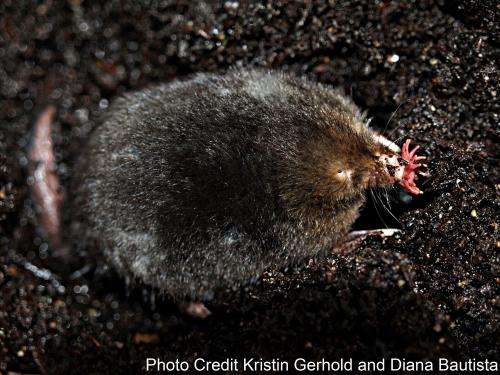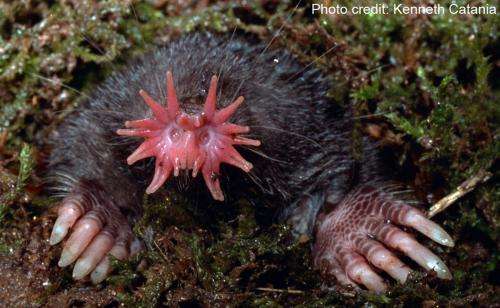Leading by the nose: Star-nosed mole reveals how mammals perceive touch, pain

The most sensitive patch of mammalian skin known to us isn't human but on the star-shaped tip of the star-nosed mole's snout. Researchers studying this organ have found that the star has a higher proportion of touch-sensitive nerve endings than pain receptors, according to a study published January 30 in the open access journal PLOS ONE by Diana Bautista and colleagues from the University of California, Berkeley and Vanderbilt University.
Touch and pain are closely intertwined sensations, but very little is known about how these sensations are detected in our cells. In this study, the authors turned to a unique species for answers: the star-nosed mole. In addition to its distinction as the fastest-eating mammal known, the star-nosed mole also possesses one of the most sensitive tactile organs known in the animal kingdom. The star on its nose has the highest density of nerve endings known in any mammalian skin, with over 100,000 fibers in a patch of skin about 1 cm. in diameter. The authors found these nerve endings significantly enriched in neurons sensitive to light touch, with a lower proportion of neurons that detect and respond to pain.

The novel touch and pain receptors they identified in the star-nosed mole were also detected in sensory receptors in mice and humans, suggesting that these receptors are likely to be more common across other mammals as well. According to the authors, their results highlight how examining diverse and highly specialized species can reveal fundamental aspects of biology common across different animals. Lead author on the study Bautista says, "By studying the star-nosed mole we identified candidate genes that may mediate touch and pain. These genes represent new potential targets for the development of much needed drugs and therapies to treat chronic pain."
More information: Gerhold KA, Pellegrino M, Tsunozaki M, Morita T, Leitch DB, et al. (2013) The Star-Nosed Mole Reveals Clues to the Molecular Basis of Mammalian Touch. PLoS ONE 8(1): e55001. doi:10.1371/journal.pone.0055001
Journal information: PLoS ONE
Provided by Public Library of Science


















